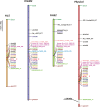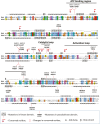Three previously characterized resistances to yellow rust are encoded by a single locus Wtk1
- PMID: 31942623
- PMCID: PMC7210774
- DOI: 10.1093/jxb/eraa020
Three previously characterized resistances to yellow rust are encoded by a single locus Wtk1
Abstract
The wild emmer wheat (Triticum turgidum ssp. dicoccoides; WEW) yellow (stripe) rust resistance genes Yr15, YrG303, and YrH52 were discovered in natural populations from different geographic locations. They all localize to chromosome 1B but were thought to be non-allelic based on differences in resistance response. We recently cloned Yr15 as a Wheat Tandem Kinase 1 (WTK1) and show here that these three resistance loci co-segregate in fine-mapping populations and share an identical full-length genomic sequence of functional Wtk1. Independent ethyl methanesulfonate (EMS)-mutagenized susceptible yrG303 and yrH52 lines carried single nucleotide mutations in Wtk1 that disrupted function. A comparison of the mutations for yr15, yrG303, and yrH52 mutants showed that while key conserved residues were intact, other conserved regions in critical kinase subdomains were frequently affected. Thus, we concluded that Yr15-, YrG303-, and YrH52-mediated resistances to yellow rust are encoded by a single locus, Wtk1. Introgression of Wtk1 into multiple genetic backgrounds resulted in variable phenotypic responses, confirming that Wtk1-mediated resistance is part of a complex immune response network. WEW natural populations subjected to natural selection and adaptation have potential to serve as a good source for evolutionary studies of different traits and multifaceted gene networks.
Keywords: Wtk1; Yr15; YrG303; YrH52; EMS mutants; phenotypic response; positional cloning; tandem kinase domains; wild emmer wheat; yellow rust.
© The Author(s) 2020. Published by Oxford University Press on behalf of the Society for Experimental Biology.
Figures





References
-
- Aaronsohn A. 1910. Agricultural and botanical explorations in Palestine (No. 180). Washington, DC: US Government Printing Office.
-
- Adachi H, Derevnina L, Kamoun S. 2019. NLR singletons, pairs, and networks: evolution, assembly, and regulation of the intracellular immunoreceptor circuitry of plants. Current Opinion in Plant Biology 50, 121–131. - PubMed
-
- Agrios GN. 2005. Plant pathology. New York: Academic Press.
-
- Appels R, Eversole K, Feuillet C, et al. . 2018. Shifting the limits in wheat research and breeding using a fully annotated reference genome. Science 361, eaar7191. - PubMed

